| Pages:
1
2
3
4
5
..
13 |
jdowning
Oud Junkie
    
Posts: 3485
Registered: 8-2-2006
Location: Ontario, Canada
Member Is Offline
Mood: No Mood
|
|
A silk 'Hadd' string (#1) is made! A 16 strand, degummed thread bundle has been twisted into a single strand 'Hadd' string.
The first objective is to twist a string with the judged minimum number of turns necessary to make a viable, uniform cylindrical string. For the small
diameter treble strings tensile strength is more important than elasticity - low twist strings being stronger than the more flexible (but weaker) high
twist strings.
The thread bundle was loaded on the twisting rig with 240 grams (previously determined from the ancient Chinese string making data). A total of 175
turns was then applied to give - what was judged to be - the minimum turns required for a cylindrical string. At this point the twisted string - under
full load - shortened in length by 17 mm.
After rubbing a Gum Arabic/Saffron dye solution into the twisted string with a piece of cotton cloth - the string then increased in length by 22 mm.
The string was then allowed to dry while still under load.
The Saffron dye solution used to dilute the Gum Arabic was made from 1 gram of Saffron herb soaked in 25 ml of 40% ethanol in water. The dye colored
the gum to a rich golden colour. The gum dilution was such that it flowed rather like the consistency of hot hide glue.
The dye enabled gum penetration/coverage of the string to be verified.
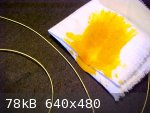
|
|
|
jdowning
Oud Junkie
    
Posts: 3485
Registered: 8-2-2006
Location: Ontario, Canada
Member Is Offline
Mood: No Mood
|
|
The result (#1 Hadd) is a smooth golden coloured string measuring 0.38 mm (0.015 inch) in diameter with a twist angle of about 10 degrees (low
twist).
However, a macro examination of the string reveals a 'hairy' surface due to the loose microscopic degummed fibroin filaments. I thought that wiping
the twisted string with Gum Arabic would cement any loose filaments of silk together but the friction of the rubbing procedure likely has produced an
even greater degree of 'hairiness'. I shall experiment later on to see if it is possible if the 'hairiness' can be smoothed out mechanically.
The little repair knot previously noted is still in evidence as a flaw conforming that all thread bundles should be free of this kind of
discontinuity.
Although the degumming procedure has been effective the silk - although silky smooth and easy to twist without friction - then becomes difficult to
handle as the silk filaments are no longer held together by the Sericin gum. On thread bundle #2 even the final knot, tying the bundle loops, had come
undone during degumming!
Much of the disturbance of the filaments of the threads may have occurred while handling the thread bundles immediately after degumming - so perhaps
with the improvements to the degumming set up as previously proposed (and more practice!) this may be less of a problem in future.
Checking again the English translation of the description of the string making process in the Kanz al-Tuhaf there is no question that the threads were
degummed before being twisted into strings after which the Gum Arabic/Saffron dye was applied.
The completed string removed from the twisting rig, after the Gum Arabic had dried, was slightly stiff so would have 'kinked' if subjected to tight
bending. The string was, therefore 'conditioned' by applying a technique developed by Alexander Rakov. The string is wrapped around a small diameter
wooden rod with a single turn and then - with the string under slight tension - the rod is rolled along the length of the string. This causes fine
cracks in Gum Arabic coating giving the string the required flexibility.
On string #1 this also caused some loosening of the twisted thread bundles causing the string to unwind a little for a few turns. This is an
indication that the Gum Arabic had not penetrated the string completely. So for string #2 a more liquid solution of the gum will be used to allow
better absorption into the string (and reduce friction on the string when rubbing in the gum).
Next, thread bundle #2 will be twisted to determine the maximum amount of twist it can take.
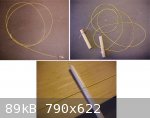
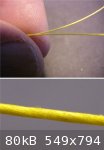
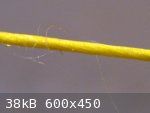
|
|
|
jdowning
Oud Junkie
    
Posts: 3485
Registered: 8-2-2006
Location: Ontario, Canada
Member Is Offline
Mood: No Mood
|
|
Lightly rubbing string #1 between the fingers seems to be effective in removing most of the silk 'hairs' from the string surface.
In doing so, a section at one end of the string - about 2 inches (50mm) long - started to partially unravel. The macro image shows that the Gum
Arabic/ Saffron dye had not penetrated to the centre of the string, remaining only on the surface. The rest of the string appears to be intact so the
problem may be confined only to this section at the end of the string.
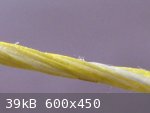
|
|
|
fernandraynaud
Oud Junkie
    
Posts: 1865
Registered: 7-25-2009
Location: San Francisco, California
Member Is Offline
Mood: m'Oudy
|
|
Dear John,
Your lab notes make my day. Proof that all is not lost.
Did you ever read Jules Verne's Mysterious Island? Written at the end of the 19th century, the novel tells of the survival of a group of
balloon-wrecked men on a desert island, thanks to the encyclopedic knowledge of one of them, the engineer Cyrus Smith. In those days it was possible
for a man to carry most of the knowledge of the human species in his head. When they quickly run out of ammunition, he remembers you can make
guncotton out of wood pulp if only you have fuming nitric acid, which he manages to synthesize from natural sources. Little by little they build a
comfortable little colony, with a farm to raise plants and animals, a telegraph to link their bases, and of course electricity from a hydro-generator,
since they are extruding wire and Smith finds magnetic ores. How many of us today could build a generator and motor from basic elements? Smith was my
hero, and it was one of my ambitions to be no worse, to at least learn and retain all the basic know-how of my civilization.
The novel ends with the discovery that in the island's extinct volcano lies the secret base of Captain Nemo, another renaissance man, whose distant
presence and occasional assistance (usually in the form of a gift of some useful objects) the colonists attributed to providence. Nemo as you may
recall was a misanthrope and an engineer, but also an artist, with a magnificent collection of musical instruments. Nemo is old and dying, he shows
himself and asks Smith, who has in part restored his faith in mankind, to sink him in his submarine after his death. As the old volcano rumbles and
consumes the island, the protagonists are picked up by a passing ship.
Your notes read like I imagine Cyrus Smith's notebooks. Thank you!
|
|
|
jdowning
Oud Junkie
    
Posts: 3485
Registered: 8-2-2006
Location: Ontario, Canada
Member Is Offline
Mood: No Mood
|
|
Thank you for your kind words and encouragement Fernand. As a youngster I did read the series of science fiction books "Les Voyages Extrordinaires" by
Jules Verne but - for some reason - not the 'sequel' that you refer to. (Perhaps it was not in the public library that I visited at the time).
I eventually gave up my chosen career as an engineer to take up more creative (much more interesting but much less remunerative!) activities later in
life.
I am posting details of my 'laboratory notes' on the forum in the hope that others - interested in the early history of the oud (or lute) might be
encouraged and enabled to try making silk strings for themselves.
After some hesitation, Hadd string#1 was put to the test today.
The test bed is a lute that I made some years ago - a copy of a late 16th C original by Giovanni Hieber, 7 courses, string length 60 cm currently
strung with Pyramid PVF trebles and metal over spun basses. The top course is a single string, the remainder unison tuned.
The lute is pitched in F at A440 i.e. the top string is tuned to f'which is about as high as a gut or silk string might be tuned to avoid frequent
breakage. (although up to a tone higher might be possible with more frequent string breakage).
The gut frets on the lute are worn way past their 'replacement overdue' date but will do for this initial test.
It so happens that the the little knot flaw in the string when under full tension has moved just beyond the nut - out of harms way.
The strings are plucked with fingertips (no nails!) using an historically correct 16th C 'thumb out' technique (The shape of my thumb nail prevents me
using the alternative 'thumb under' technique of the period).
The string is still 'settling in' but I am quite surprised at the sound which is as clear and resonant as the PVF strings but with a more complex
'woody' sound - hard to describe. So here is a brief mp3 clip of the string sound recorded with a Zoom H2 digital recorder.
If I can figure out how to compress the audio file below 1 Mb, will post a clip of a lute piece showing how the string performs together with the
other strings.
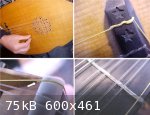
Attachment: STE-006 clip.mp3 (450kB)
This file has been downloaded 587 times
|
|
|
jdowning
Oud Junkie
    
Posts: 3485
Registered: 8-2-2006
Location: Ontario, Canada
Member Is Offline
Mood: No Mood
|
|
OK - here is a short mp3 clip from the second half of the lute part of the dance 'Le Gratie d'Amore' from Cesar Negri's 'Nuove Inventioni di Balli' of
1604.
Still getting used to the lower pitch and string tension but it gives an idea of the sound of the silk treble. The treble part goes as high as the 7th
fret
Attachment: STE-007 mp3.mp3 (535kB)
This file has been downloaded 597 times
|
|
|
DaveH
Oud Junkie
    
Posts: 526
Registered: 12-23-2005
Location: Birmingham, UK
Member Is Offline
Mood: No Mood
|
|
Well, I guess it's early to tell, but to my ear it sounds like a major success. It has a really sweet sound and is very bright, which is pretty
impressive given the scarcity of existing information on silk lute/oud strings. It sounds like you also went as far as the 7th fret in the first
sample. How well does it keep intonation beyond that? I would imagine it's fairly even thickness as the threads are presumably uniform and the same
threads run the entire length of the string.
One thing I was wondering though. Do you have any information on tensile strength of silk relative to gut (apologies if I missed this earlier in your
thread)? I would imagine it would be stronger and therefore would perhaps be able to go beyond F. It would be interesting (but probably heartbreaking
given the amount of work that went into this) to test the breaking strain of a sample string.
Anyway, preliminary congratulations!
|
|
|
jdowning
Oud Junkie
    
Posts: 3485
Registered: 8-2-2006
Location: Ontario, Canada
Member Is Offline
Mood: No Mood
|
|
Thanks Dave H. The first result is certainly encouraging.
Note that the sound files have been compressed by about 10 times so some acoustic detail has been lost in the conversion (i.e. it sounds even better
in the original recording). Also note that the files are 'raw' data as recorded by the Zoom H2 digital recorder with no editing or effects added. The
recorder was positioned above the lute at about 2-3 ft distance away.
Replacement of the badly worn frets on the test bed lute will no doubt make another big improvement in the sound.
I do not have reliable comparative data on tensile strength of silk and gut but I would expect silk to be stronger - the ancient writers on the oud
certainly thought so preferring silk for the treble strings as they not only sounded better but could be made smaller in diameter than gut.
Silk is said to be stronger than steel (but it depends upon the steel I suppose) - almost equivalent to Kevlar. It is attracting a lot of attention
today (together with spider silk that is even stronger) for commercial applications of artificially spun fibroin filament that is more uniform than
natural silk.
Silk filament will stretch to 13% of its original length before breaking but has poor elasticity (i.e. once stretched does not recover to its original
length). So, like gut bass strings, silk strings must be made more elastic by virtue of their twisted or roped construction - more twist = greater
elasticity = lower tensile strength.
The dilemma for modern historical string makers is that the gut or silk available in Medieval or Renaissance times may have been significantly
different than is available today - the properties of both materials being dependant upon the strain of the moth or breed of sheep, their feed and
environmental conditions etc.
I suspect that the 60 cm low twist Hadd #1 string will go to a higher tension and pitch (g' at A440 perhaps) but I am starting at f' to see how the
string holds up to the stress of being played before increasing pitch. All of the experimental strings will be carefully tested to destruction -
plenty more where they came from!
After 24 hours at full tension, the Hadd #1 string is still stretching a little but now seems to be stabilising in pitch. So far the string, under
full load, has stretched to about 5% of its original length of 60 cm (judging from the movement of the little repair knot). Interestingly, the
diameter of the string has not changed under tension from its original 0.015" diameter (0.38 mm).
The gummed string is not sticky in any way under the fingers but has a good tactile 'grip' for fingertip playing (unlike plain nylon) and has a
brightness equivalent to PVF but a more interesting tone colour (in my opinion).
It remains to be seen how well the gum coating will wear in service. However, as the gum is water soluble, it may be possible to maintain a string by
wiping off the worn gum with a hot moist rag and then rejuvinate the string with a new coating of gum. Something to experiment with.
For information I have attached another sound clip of the string sounded 'open' and as far as the 12th fret position. The test bed lute has only 8
frets to the end of the fingerboard (typical of lutes of the period). Lutes of the period were played above the 8th fret onto the sound board without
use of frets. The early lutes had this area of the sound board made more durable with a hard varnish coating as can be seen in the attached image of a
painting of a lutenist (Francesco da Milano?) dating from the first half of the 16th C.
High twist Hadd #2 has been made - more to follow.
Attachment: Hadd 1 clip.mp3 (257kB)
This file has been downloaded 585 times

|
|
|
jdowning
Oud Junkie
    
Posts: 3485
Registered: 8-2-2006
Location: Ontario, Canada
Member Is Offline
Mood: No Mood
|
|
" A paste of moderate consistency is then made of the gum and a little essence of saffron. This is rubbed on the strings with a piece of linen until
it has penetrated into all the parts, when the string is dried" (Kanz al-Tuhaf)
Although the Hadd #1 string appears to be uniformly and smoothly coated with Gum Arabic, unraveling a section of the string confirms that only the
outer threads have been coated with the gum. Indeed, it would seem to be impossible (from this one experience) for the gum to completely saturate the
relatively tightly wound string to its core (if that is what 'penetrated into all the parts' is taken to mean).
The attached macro image shows that a majority of the threads in the string remain free of gum (note the now sericin free microscopic fibroin
filaments - confirming the efficiency of the initial degumming procedure). The Gum Arabic in this case is, therefore, a surface coating that fills
only the external irregularities of the string.
To test if complete gum penetration is possible the Gum Arabic will be further diluted before being applied to Hadd #2 string. Also instead of using a
piece of fine cloth (which absorbs the gum) the gum will be rubbed in with the fingers - wearing non absorbent vinyl gloves.

|
|
|
jdowning
Oud Junkie
    
Posts: 3485
Registered: 8-2-2006
Location: Ontario, Canada
Member Is Offline
Mood: No Mood
|
|
Hadd #2 - made from a 16 thread bundle like Hadd #1, loaded with a 240 gram weight, was twisted 525 turns (compared to 175 turns for Hadd #1). This
produced an angle of twist in the threads of about 45 degrees (compared to 10 degrees for Hadd #1 - see attached image) and a reduction in length of
13 cm from the original untwisted length of 100 cm. The string diameter increased to 0.41 mm (0.016 inch) - compared to 0.38 mm diameter for Hadd #1.
This seemed to be an extreme angle of twist so twisting was stopped at this point - not wanting to test this string to destruction.
The Gum Arabic solution was further diluted with the addition of 5 ml of 40% vodka making a fairly fluid solution but with a less intense dye colour.
This was rubbed into the string with gloved fingers - several applications being made. However, this resulted in an unsatisfactory coating that broke
apart due to rubbing in the gum as it became 'tacky' or partly dry. The advantage of using a cloth pad to apply the gum is that the cloth absorbs some
of the liquid gum - acting as a reservoir and so slowing down drying of the gum. So, we live and learn - and no doubt the ancients would be saying 'I
told you so"!
Rather than scrap this string, a cloth pad was moistened with hot water and rubbed over the string which quickly and effectively removed the crusty
gum layer. The cleaned string was then successfully recoated with gum - this time using a slightly damp cloth pad to reduce absorption of the gum into
the pad. The less intense dye colour made coverage of the string with the gum a little more difficult to judge.
The larger broken silk filaments seen in the cleaned string may be an indication that a maximum degree of twist has been reached but is more likely to
be due to mechanical damage during the first, unsuccessful, gum application.
The short black fibres seen in the images may be foreign material attached to the raw silk as well as from the cotton cloth used to apply the gum.
Some small black particles were also in evidence that likely came from the wood ash used for degumming the raw silk.
The slight surface irregularities seen in the surface of the re-coated string will likely smooth out once the string is brought up to an estimated
full tension of around 3.0Kg (f') or a possible 3.7Kg (g').
The next test will be to twist a 16 thread bundle to destruction - to determine the maximum degree of twist possible.
Improvements to be made for the next string:-
1) Filter the wood ash from the degumming solution so that the strings boil in a clear caustic solution.
2) Make a copper cylinder to hold each thread bundle securely during degumming to prevent tangling and mechanical damage to the threads.
3) Increase the viscosity of Gum Arabic by evaporation and then dilute again with the concentrated 'essence of saffron' solution - to increase the
intensity of the dye colour to the original golden yellow. This will help in judging gum coverage of a string.
4) I have a stock of very fine linen cloth salvaged from old engineering drawings. This will be used in place of the cotton cloth for application of
gum - for greater 'authenticity'.

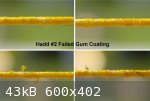
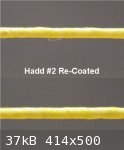

|
|
|
jdowning
Oud Junkie
    
Posts: 3485
Registered: 8-2-2006
Location: Ontario, Canada
Member Is Offline
Mood: No Mood
|
|
After 4 days of playing Hadd #1 on the test-bed lute at f' (A440) pitch, one of the threads of the 16 thread string broke at the 5th fret. The damage
is mechanical - due to the worn gut fret cutting into the string so is not a tensile failure.
Some 'hairiness' of the string was also seen - under magnification - just below the rosette where the string is plucked. This is (less severe)
mechanical damage - the 'hairiness' being due to broken microscopic Fibroin filaments appearing on the surface of the string.
As a test, the broken thread was cut away on either side of the fret position and the string was re-coated with fresh Gum Arabic. This sealed the
broken thread securely in place as well as any 'hairiness'.
With this string maintenance completed testing continued for another 24 hours when another thread broke - again at the 5th fret.
Macro examination of fret #5 reveals worn, sharp edges (the string has been pulled to one side for clarity in the image). This wear of the fret would
not have damaged a nylon or PVF string (more likely it is these strings that caused the fret damage in the first place - the nylon/PVF being harder
than gut).
The test of Hadd #1 has, therefore, been terminated at this point. The test bed lute will now be re-fretted with new gut (long overdue!) before
proceeding with a test of Hadd #2.
The new fretting will be double strand (rather than the current single strand of gut). A double fret wrapping is more historically appropriate and has
the advantage of increasing fret useful life (the wear being shared over two gut strands rather than one) and enables the frets to be tied tighter to
the neck/fingerboard.
It is interesting to contemplate why the Medieval Persian string makers chose a different path to that of the Chinese - preferring to de-gum the silk
threads before twisting - and then applying Gum Arabic as a binder - rather than working with the silk's natural gum Sericin. De-gumming the silk is
an additional procedural complication and makes handling of the silk threads more difficult. It is unlikely that the Persians were unaware of how the
Chinese made their strings (the string making information was, after all, published in printed Chinese books of the period so was not a secret).
There is a significant tone colour difference between strings made from raw silk and those made from de-gummed silk (ref. Alexander Rakov) - so maybe
it was just a matter of auditor preference . However, use of Gum Arabic to bind the string threads together in place of the Sericin does have a
potential advantage in allowing the string life to be easily extended by re-coating with gum as necessary. Perhaps this may have been a factor?
There is no information to confirm that the de-gumming procedure of the Kanz al-Tuhaf was thorough enough to remove all traces of Sericin or only
(most likely) partially so. So we must 'remain in the dark' on that question.
Silk strings made the old Persian way, would seem to be sensitive to mechanical failure due to abrasion (based upon our extensive experience with Hadd
#1!). Perhaps this is one reason why frets were eventually abandoned on the oud - because they contributed to excessive string wear? Just speculating!
Note , however, that the thin Hadd trebles will be more susceptible to failure than the more substantial basses - higher tension, smaller diameter.
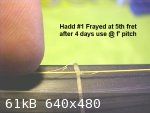
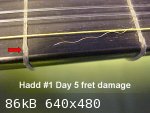
|
|
|
jdowning
Oud Junkie
    
Posts: 3485
Registered: 8-2-2006
Location: Ontario, Canada
Member Is Offline
Mood: No Mood
|
|
The 'test bed' lute has now been re-fretted. It will take a while for the frets to settle in and be fine tune adjusted.
Hadd #2 has been fitted and is still being stretched to full tension (f' at A440) so it is early days to judge. First impressions are that the string
has a bright sound and tone colour (like Hadd #1) but feels a little too 'stretchy' when being plucked. This might be explained by the fact that Hadd
#2 is a high twist string (higher twist = greater elasticity).
Back to the question of Gum Arabic.
"A paste of moderate consistency ..." (Kanz al-Tuhaf).
At the outset I have assumed that 'paste', in this context, means 'a moist, fairly stiff mixture'. However, from the initial tests it is clear that if
the Gum Arabic is made too stiff or viscous it will not 'penetrate into all the parts' of a tightly twisted string - no matter how hard it is rubbed
in.
Another meaning of 'paste' is a relatively weak adhesive used to stick paper together (e.g flour and water paste). So -should the translator of the
Kanz al-Tuhaf text more accurately have used the word 'glue' instead of 'paste'?
Gum Arabic can be used as a glue for paper (when suitably diluted - in order to make it flow so that it is easy to apply with a small brush). I
imagine then that Gum Arabic, made as a glue, would have had a 'watery', varnish like fluidity - similar to the liquid mucilage glue that was once
commonly used in schools, in offices and around the home until the early 1960's. One popular brand was LePage's mucilage glue that came in a fancy
bell shaped bottle with a red rubber 'Gripspreader' cap. I remember it well but it seems that this product is no longer available having been replaced
in recent years by synthetic glues (but probably these products are still called 'mucilage glue').
Strictly speaking, vegetable mucilage is not identical to natural vegetable gum but is similar to the point where the terms 'mucilage' and 'gum' are
interchangeable in common usage when referring to glue.
I think that I can still recall how LePage's mucilage glue flowed from the bottle so will further dilute my Gum Arabic solution accordingly with the
'essence of saffron' - to try on the next experimental string. Hopefully this will result in a better penetration of the gum into the string.
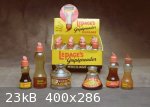
|
|
|
jdowning
Oud Junkie
    
Posts: 3485
Registered: 8-2-2006
Location: Ontario, Canada
Member Is Offline
Mood: No Mood
|
|
Hadd #2 string broke today at full tension (f' @A440) after only 20 hours and before stretching fully. The break was at the front edge of the nut -
this being the point of highest stress for the string.
Although Hadd #2 is less than perfect, the reduced service life (compared to Hadd #1) is not altogether unexpected due to its high twist
construction.
Hadd #1 was made with a 10 degree angle of twist. So for a string tension of 3 Kg, the twisted threads in the string would have to sustain a tensile
load of about 3.1 Kg. By comparison, for the Hadd #2 string, with a 45 degree angle of twist, the twisted threads would need to sustain a tensile load
of about 4.2 Kg. This stress load is further increased at the nut due to the stress concentration in that location - clearly too much for a string of
this dimension and structure to sustain. So no surprises here - confirming that a simply twisted Hadd string should be made with as low a twist as is
practical.
In order to gain as much information as possible from the failed Hadd #1 string, a section was coated with a thin rubbing varnish ("Minwax - Antique
Oil Finish"). The result is a smooth flexible string that may have better abrasion resistance than Gum Arabic? Something to investigate further.
The flexibility of historical strings (gut or silk) should allow them to be tied like 'bundles of shoe laces' as is Mimmo Peruffo's (Aquila Strings)
apt description.
Four thread bundles - 0ne 16 thread and three 8 thread have been prepared for testing. The 16 thread bundle will be tested to determine the maximum
degree of twist that it can sustain. One of the 8 thread bundles will be similarly tested. The remaining two 8 thread bundles will then be twisted
into a 2 strand Hadd string - just to see what happens.
To de-gum the thread bundle samples, they have been wound on to a 'de-gumming' tube - to keep the thread bundles separate and under control to ease
handling.
The tube has been made from a 4X4 ABS plastic sewer pipe connector (available from any hardware store). The surface of the connector was first
inspected for any rough spots that might break the silk threads. These were smoothed off with fine sand paper. Self tapping screws set in the
connector serve as anchor points for the thread bundles - tied with string to the anchors.
The de-gumming solution was made by dissolving wood ash in water (25 grams / litre). The wood ash was wrapped in a fine cotton cloth (to keep the
solution clear of ash debris) before being immersed in water that was then brought to the boil. The PH of the solution, after a few minutes of
boiling, reached about 10 (tested with PH indicator papers) The 'degumming tube' was then fully immersed in this solution and allowed to simmer for 30
minutes. The tube was then removed, thoroughly rinsed in clean water, and set aside to dry.
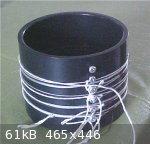
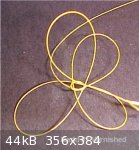
|
|
|
jdowning
Oud Junkie
    
Posts: 3485
Registered: 8-2-2006
Location: Ontario, Canada
Member Is Offline
Mood: No Mood
|
|
The degummed 16 strand and 8 strand bundles have been twisted to destruction to determine the maximum number of turns that can be carried by each.
This information is required for multistrand string construction where each strand (or thread bundle) must first be twisted to the maximum degree
before being combined (or 'laid') together.
How is the maximum degree of twist determined? It is the point - before the threads break - where the thread bundle is so tightly twisted that it
begins to take up a distorted 'wave' form - from the desired uniform cylinder.
For the 1 metre long 16 thread bundle - loaded at 240 grams - this point was judged to occur at about 550 turns. This thread bundle broke at one of
the end loops at just over 800 turns.
For the 1 metre long 8 thread bundle - loaded at 120 grams - twisting continued until the thread bundle broke at about 1150 turns. However, maximum
twist was judged to occur at about 1000 turns (by examination of the bundle under magnification as twisting progressed).
The difference between the results for the two bundles can be explained by the diameter difference of the twisted bundles. The threads in the 16
thread bundle are under greater tension than those in the smaller diameter 8 thread bundle.
The attached images show the graphical plots of the contraction in length of each thread bundle against the number of turns - measured on the test rig
as twisting progressed.
The broken 16 strand thread bundle was allowed to fully unwind (with a small load attached to one end) and was then re-twisted to the low twist limit
of 175 turns. The string was then coated with gum so that it could be tried on the lute test bed.
This time, fine linen cloth was used to rub a more dilute Gum Arabic solution into the string. Application of gum with a dry linen cloth produced an
uneven coating. This was wiped away with a cloth soaked in hot water and a new gum application made - this time with the linen cloth first soaked in
water - which produced an even coating of gum.
This string - Hadd #1A (low twist)- is now under trial on the test bed lute.


|
|
|
DaveH
Oud Junkie
    
Posts: 526
Registered: 12-23-2005
Location: Birmingham, UK
Member Is Offline
Mood: No Mood
|
|
Hi John
I'm no expert on this, but I was under the impression that flexibility was more important for base strings, to enable unloaded/plain strings to
function at normal tensions and string lengths. Is it really that important for treble strings? If not, how about trying a low twist version, which
would presumably be more resilient?
|
|
|
jdowning
Oud Junkie
    
Posts: 3485
Registered: 8-2-2006
Location: Ontario, Canada
Member Is Offline
Mood: No Mood
|
|
That's correct DaveH. This has already been demonstrated by the Hadd #1 (the low twist version) versus Hadd #2 (high twist) comparative tests (Hadd #1
lasted 4 days whereas Hadd #2 lasted less than a day at the same pitch of f' (A440).
There is a practical limit to the minimum number of twists dictated by string uniformity considerations (a string must be uniformly cylindrical).
The current trials of the 8 and 16 thread bundles (strands) previously posted is to establish data so that the bundles can be used as 'building
blocks' for a more complex and elastic bass string construction e.g. 4 X 16 strand to make a Bamm string or a 2 X 16 strand (or 4 X 8) Mathna string
or a 2 X8 Zir string. A basic 12 thread bundle 'building block' awaits destructive testing (for a 2 X 12 Zir string or 4 X 12 Mathlath string).
Thankfully there are not too many alternative combinations to test but the simpler the string construction that will work the better.
I will also make a 64 thread, simply twisted, Bamm string - just for comparison - but am pretty sure that this will not have the elasticity required
at 'normal' working tensions. But - hard to say at this stage what the optimum construction will be for each string type without further trials.
|
|
|
jdowning
Oud Junkie
    
Posts: 3485
Registered: 8-2-2006
Location: Ontario, Canada
Member Is Offline
Mood: No Mood
|
|
Just for clarification - DaveH commented in his previous post about string 'flexibility' although he probably meant string 'elasticity'?
An instrument string must have sufficient elasticity to function well - i.e. if it is stretched slightly (within its elastic limit) it will return to
its original length.
All elastic instrument strings are flexible (pliable - can be bent) to a certain degree. However, early lute strings demonstrated extreme flexibility
in that they were sold in long lengths tied up like bundles of shoe laces (known as 'knots').
The attached image of a 16th C engraving of a lute string 'knot' demonstrates this extreme degree of flexibility.
Hans Holbein depicted an image of a lute, with seemingly photographic accuracy and detail, in his famous painting "The Ambassadors", 1533. The lute
has a broken octave treble string on the fourth course - seen below the pegbox and at the bridge. Note how flexible this string appears to be.
Compare this to a modern plain gut instrument string - supplied carefully wound (in short lengths) in a coil to avoid any sharp bends or 'kinks' that
might spoil the string. This is an example of low string flexibility (but probably a string that may have adequate elasticity).
Modern (20th C) Chinese silk instrument strings are of four strand roped construction. These are flexible strings but supplied (probably for
convenience or by tradition) in coils. The length of string in the image is about 10 metres.
The objective of these trials is to make silk strings with both extreme flexibility and adequate elasticity to perform well acoustically. Durability
of a string is another important objective - although lack of durability of the thinnest treble strings (under the highest tension) has always been
problematic.
We do not know, however, how flexible the early oud strings were. My hunch is that they were as flexible as the early lute strings apparently were -
be they gut or silk.
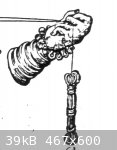
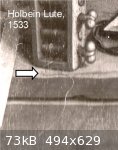

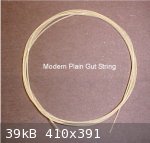
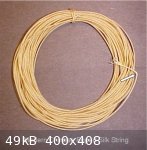
|
|
|
DaveH
Oud Junkie
    
Posts: 526
Registered: 12-23-2005
Location: Birmingham, UK
Member Is Offline
Mood: No Mood
|
|
Hi John, no I meant flexibility in the sense that you use the word in the post above, not elasticity. I hadn't realised you were testing high twist
strings with a view to using them for bases.
As I understand it, flexibility is a more important quality for base strings, but it seems to me that gut might have more potential in this regard
than silk - even though we don't have any clue these days how historical stringmakers managed to achieve such a high degree of flexibility in gut.
I also wonder whether gut is better suited to base strings as it's likely to be possible to achieve a higher linear density (which can be further
increased by "loading" with metal salts, among other methods). Silk fibres are hollow and I would imagine this means you'd need a much thicker string
to achieve a given linear density.
As I say, I know very little about historical string making, especially for the oud. Is there any evidence that silk was used on oud bases? It would
seem to me that silk (strong, light and stiff) was more suited for treble strings whereas gut (heavier and theoretically more flexible) was better for
mid and bases.
But this is all fascinating to me.
|
|
|
jdowning
Oud Junkie
    
Posts: 3485
Registered: 8-2-2006
Location: Ontario, Canada
Member Is Offline
Mood: No Mood
|
|
Thanks for your interest and comments DaveH.
The historical string makers today achieve both improved flexibility and elasticity of gut strings by either increasing the degree of twist or by
using a multi-strand (roped) construction. The same principles apply to strings made from silk filament.
Mimmo Peruffo of Aquila strings has shown me gut strings he has made that are flexible enough to be tied up like a packet of shoe laces without being
damaged. So even with modern gut this extreme level of flexibility is a practical objective.
The density of silk varies (as does that of gut) but on average (for modern silk versus modern gut) silk is more dense.
Silk filament is not hollow but is solid 'Fibroin' protein. On the other hand gut (being animal intestine) is hollow if used whole (as they likely
were in the early lute strings that had a distinct 'taper' along their length). Although, of course, this cavity would probably count for nothing once
the gut strands had been twisted and compressed.
Once de-gummed, silk will readily accept dyes (de-gumming is an essential part of the dyeing process) as well as absorb metal salts that can increase
its density by up to 400% (it is claimed). Metal salts were used in the 19th C (and likely in much earlier times) to 'weight' silk, causing it to
drape or hang better. The downside of 'weighting' is that it weakens the silk eventually causing it to 'auto destruct' - silk clothing literally
falling apart in storage - the bane of Museum curators concerned with conservation of historical artifacts. The early Chinese string making texts warn
against using the silk from cocoons that have been adulterated by 'weighting' with salts (silk being sold by weight) as it makes inferior strings.
As instrument strings have a relatively short service life, 'weighted' silk strings might be a practical possibility. Mimmo has tried this for gut
basses with some success. However, for these trials, only unadulterated silk filament will be used.
The early Arabian and Persian texts referring to oud strings say they were made from both gut and silk.
Ziryab (9th C) is said to be the first to use silk strings (for the four course oud of the time).
Al-Kindi (9th C) specified gut for the Bamm and Mathna basses and silk for the Mathlath and Zir trebles - made to the same gauge or diameter as if
they were made of gut. Silk was used as it had a finer tone than gut and could withstand a higher tension than gut was capable of withstanding.
The 10th C Ikhwan al-Safa text specifies that all strings (four course oud) were made from silk.
The Persian 14th C Kanz al-Tuhaf specifies both silk and gut as a string material for the five course oud. However, gut is only mentioned as being
used for the Bamm and Mathlath basses whereas only silk is specified for all of the strings.
It is the silk string specification in Kanz al-Tuhaf that is being used as the basis for these experiments.
|
|
|
jdowning
Oud Junkie
    
Posts: 3485
Registered: 8-2-2006
Location: Ontario, Canada
Member Is Offline
Mood: No Mood
|
|
Hadd #1A failed after 21 hours on test - while being brought up to pitch. The failure was a tensile break just behind the nut (highest stress
location). This matches the (low) durability performance of the high twist Hadd #2.
Hadd #1A was made from the 16 thread bundle tested to failure with over 800 turns. The bundle was allowed to fully untwist before being re-twisted to
a low twist string of 175 turns (like Hadd #1). It would appear then that the silk filaments having been stressed beyond their elastic yield point
and, so weakened, failed prematurely under test. So, no big surprise in retrospect.
The next step is to make a 2 strand string (8 threads per strand) using the early Chinese string making procedure. This is the first step in making
multistrand experimental strings of 2, 3 and 4 strands - just to see how they turn out.
As the 2 strand string will have a total of 16 threads in its construction (2 X 8 thread bundles) it will be nominated Hadd #3.
BTW - for information - DaveH raised the question about comparative values of density of silk and gut. The best information that I have is that the
density range of modern gut and degummed silk is 1.20 to 1.40 gm/cc for gut and 1.30 to 1.45 for silk. However, if the silk is not fully degummed (as
in the early Chinese method of string making) the residual Sericin component increases the density of the raw silk to about 1.58 to 1.66 gm/cc.
Note also that Gum Arabic, being of greater density than Sericin, when added to degummed silk will increase its linear density - which is what is
being done in these experiments.
|
|
|
jdowning
Oud Junkie
    
Posts: 3485
Registered: 8-2-2006
Location: Ontario, Canada
Member Is Offline
Mood: No Mood
|
|
The two 8 thread bundles for Hadd #3 were first twisted separately on the rig to 875 turns each - lower than the 1000 turn maximum twist limit
previously established in order to provide a factor of safety.
The twisted bundles were then attached to a hook together with the 120 gram weights being careful not to allow the tension to relax. The two strands
were then together - top and bottom - with some cotton thread and the whole assembly allowed to rotate freely under the influence of gravity. This
resulted in an even, open twisted two strand string of stable construction (i.e. a yarn).
The string was then rubbed with Gum Arabic and allowed to dry.
Interestingly, each strand when twisted to 875 turns reduced in length from 100 cm to 80 cm. After combining the strands, the string length increased
to 88 cm and then to 89 cm after applying the gum coating - an 11% reduction in length.
According to the early Chinese string making accounts, however, strings made this way should end up by being 40% shorter. This implies that the
Chinese must have added additional turns to the combined strands - in order to create a smoother string perhaps (although the early texts make no
mention of this additional step in the string making process).
Note that the Chinese strings were usually of four strand construction (but sometimes 3) never two strand - presumably in order to make a 'smoother'
string
The open twist construction of Hadd #3 would seem to make it an unlikely candidate for a treble string because, although it is uniform, it is not a
uniform cylinder (although the cross section does come close to being circular). Nevertheless, the string has now been put to the test on the lute.
Note that plucked, wire strung fretted instruments of the 16th/17th C - like the orpharion and bandora - used brass strings of this two strand
construction for their basses.
Hadd #3 test results to follow.
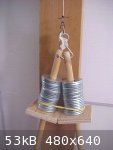

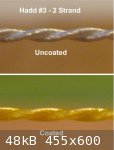
|
|
|
jdowning
Oud Junkie
    
Posts: 3485
Registered: 8-2-2006
Location: Ontario, Canada
Member Is Offline
Mood: No Mood
|
|
The Hadd #3 string felt a little unfamiliar under the fingers on test - not being 'smooth' to the touch (compared to a monofilament PVF string) and
more flexible. Plucking the string was more difficult to control, the finger tips tending to 'grab' the open twist causing slight string "clatter" on
the frets. This can be heard on the attached audio clip - although, overall, the sound was judged to be bright and 'silvery'. The extra flexibility
also has the advantage of providing a clear response when stopping the string beyond the frets on the lute.
This string stretched 8% in length when initially brought up to pitch (f'@A440). After 43 hours in service the string failed while being tuned up to
pitch - the failure again occurring just behind the nut (one of the two strands broke).
It is clear, from the tests so far (as anticipated), that the best string construction for the thin Hadd treble is a simply twisted string with a low
angle of twist - this being the strongest configuration.
The next step will be to jump to the 'other end of the spectrum' and make a simply twisted 64 thread Bamm string for comparison before going too far
into multi strand string construction.
For this trial a low, medium and high twist string will be made and tested. A 64 thread bundle will first be tested to destruction to determine the
maximum number of twists it can take. I don't like breaking strings but, after all, one has to 'break eggs to make an omelette'!
Attachment: Hadd 3 test.mp3 (676kB)
This file has been downloaded 546 times
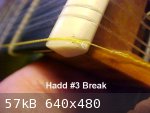
|
|
|
jdowning
Oud Junkie
    
Posts: 3485
Registered: 8-2-2006
Location: Ontario, Canada
Member Is Offline
Mood: No Mood
|
|
Winding the silk threads between the two wooden dowels on the twisting rig is slow and inconvenient - not too bad for a 16 thread bundle Hadd string
requiring only 8 full turns around the pegs but for a Bamm thread bundle of 64 threads requiring 32 turns, a more efficient method is required.
The 'strand winder' (let's call it that) has been quickly and easily made from scrap materials. Essentially a wooden cruciform winding frame on a
support frame with a holder for the silk bobbin. The silk thread is fed through a plastic coated hook to guide the silk thread centrally onto the
winding frame. The left hand applies light friction to the bobbin to maintain constant slight tension to the thread during winding while the right
hand rotates the winding frame.
Three removable peg positions have been provided on the winding frame to give strand lengths of 100, 110, and 120 cm
as required dependent upon string reduction in length after twisting (at present unknown for a silk Bamm string).
Once the required number of turns have been made, the thread ends are tied and the thread bundle or strand then transferred to the twisting rig.
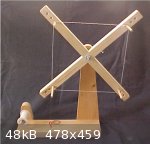
|
|
|
jdowning
Oud Junkie
    
Posts: 3485
Registered: 8-2-2006
Location: Ontario, Canada
Member Is Offline
Mood: No Mood
|
|
I attach revised test graphs (previously posted) for establishing experimentally the maximum twist for 8 and 16 thread bundles. These are now named
Plot A and Plot B respectively.
The revision superimposes - for comparison and information - optimum minimum and maximum string twist derived from a formula by Alexander Rakov
established during the course of his development work in making simply twisted silk strings using the Chinese method of using reeled raw silk filament
(thread) rather than - in our case - degummed silk.
Alexander found that the optimum number of turns needed to make workable strings could be calculated according to the following relationship:
Number of turns (N) = Co X Length of thread bundle (untwisted) divided by the square root of the number of individual filaments in a bundle.
The Coefficient of Twist (Co) varying between 25 and 37.6.
It should be noted that in our case, each thread is comprised of two reeled filaments.
In Plot A it can be seen that the maximum twist arrived at by experiment (1000 turns) agrees closely with the Rakov calculated value. (In this
experiment the minimum twist value was of no interest). Interestingly the maximum and minimum twist values lie over that central portion of the
graphical plot that is essentially a straight line.
In plot B, the Rakov values again lie pretty well on the central straight line section of the graphical plot.
The twisting rig experiment established a high twist value for the Hadd #2 string of 525 turns which falls midway between the Rakov calculated
values.
However, the Hadd #1 minimum possible twist that was established (for maximum strength) - judged experimentally at 175 turns - is a significantly
lower value than the calculated minimum of 439 turns.


|
|
|
jdowning
Oud Junkie
    
Posts: 3485
Registered: 8-2-2006
Location: Ontario, Canada
Member Is Offline
Mood: No Mood
|
|
The degumming tube has been modified in an effort to make the degumming procedure more efficient. Small plastic tubes have been fitted to the main
body so that one end loop of a thread bundle can be attached to one tube, wrapped around the main body and the other end loop attached to the nearest
tube with a thin elastic band (to keep each thread bundle in place under slight tension).
Unfortunately with this arrangement a 16 thread bundle and 64 thread bundle on test did not fully degum - the threads being glued together to make a
silken tape together with small patches of sericin where the elastic bands had come into contact with the threads during the degumming procedure.
Furthermore, the 16 thread bundle had snapped under the tension of the elastic band.
So - back to the drawing board! Degumming of the strands is not going to be easy if complete removal of the sericin is to be achieved without
significant loss of strength of the silk threads.
Nevertheless, rather than waste the partially degummed thread bundles it was decided to proceed to subject these failed samples to maximum twist
testing - just to see what might be learned.
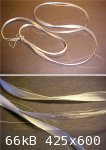
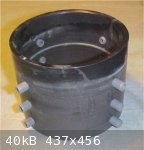
|
|
|
| Pages:
1
2
3
4
5
..
13 |